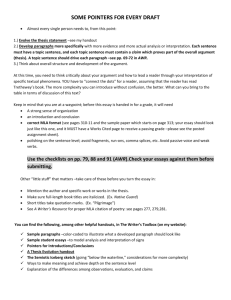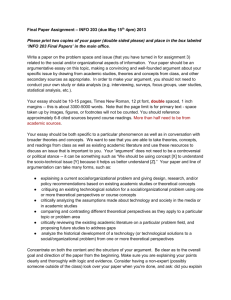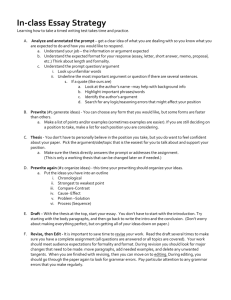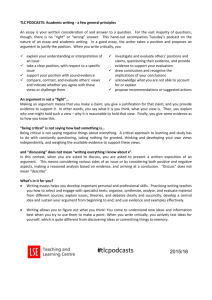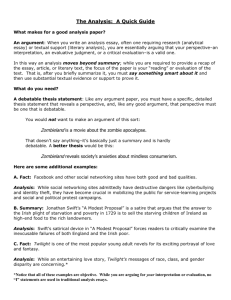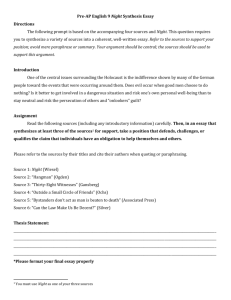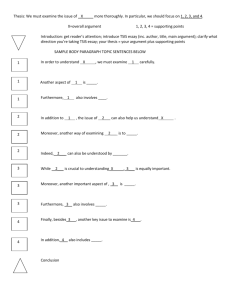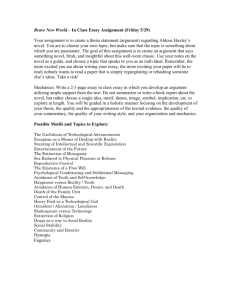The ability to manipulate language is crucial to making a good
advertisement
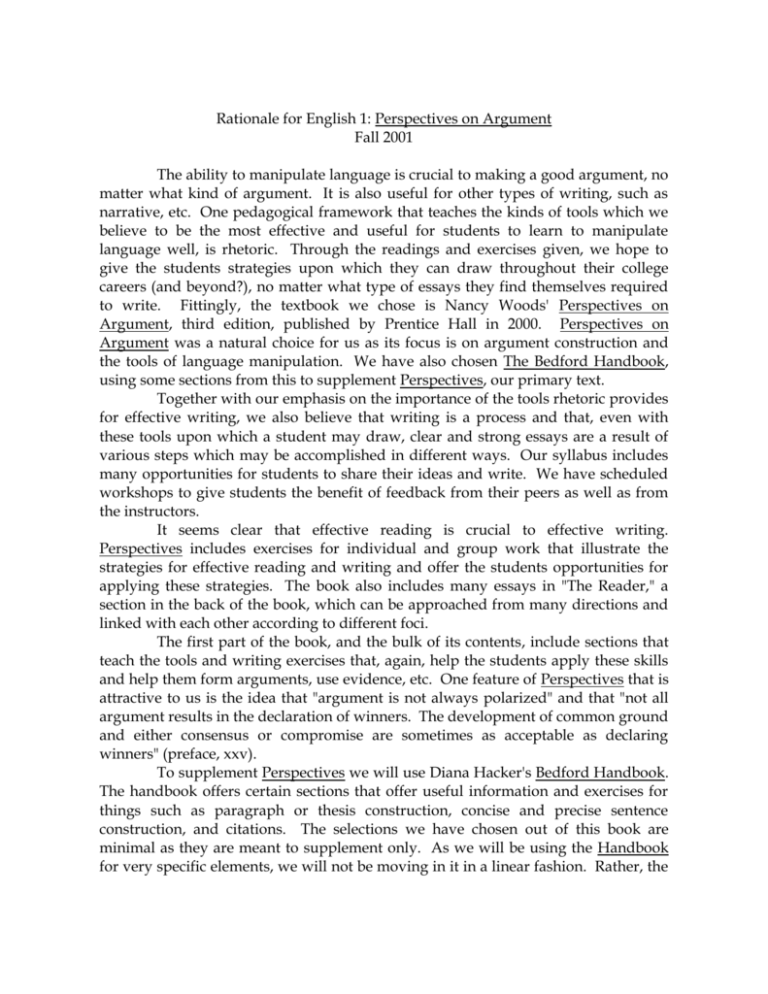
Rationale for English 1: Perspectives on Argument Fall 2001 The ability to manipulate language is crucial to making a good argument, no matter what kind of argument. It is also useful for other types of writing, such as narrative, etc. One pedagogical framework that teaches the kinds of tools which we believe to be the most effective and useful for students to learn to manipulate language well, is rhetoric. Through the readings and exercises given, we hope to give the students strategies upon which they can draw throughout their college careers (and beyond?), no matter what type of essays they find themselves required to write. Fittingly, the textbook we chose is Nancy Woods' Perspectives on Argument, third edition, published by Prentice Hall in 2000. Perspectives on Argument was a natural choice for us as its focus is on argument construction and the tools of language manipulation. We have also chosen The Bedford Handbook, using some sections from this to supplement Perspectives, our primary text. Together with our emphasis on the importance of the tools rhetoric provides for effective writing, we also believe that writing is a process and that, even with these tools upon which a student may draw, clear and strong essays are a result of various steps which may be accomplished in different ways. Our syllabus includes many opportunities for students to share their ideas and write. We have scheduled workshops to give students the benefit of feedback from their peers as well as from the instructors. It seems clear that effective reading is crucial to effective writing. Perspectives includes exercises for individual and group work that illustrate the strategies for effective reading and writing and offer the students opportunities for applying these strategies. The book also includes many essays in "The Reader," a section in the back of the book, which can be approached from many directions and linked with each other according to different foci. The first part of the book, and the bulk of its contents, include sections that teach the tools and writing exercises that, again, help the students apply these skills and help them form arguments, use evidence, etc. One feature of Perspectives that is attractive to us is the idea that "argument is not always polarized" and that "not all argument results in the declaration of winners. The development of common ground and either consensus or compromise are sometimes as acceptable as declaring winners" (preface, xxv). To supplement Perspectives we will use Diana Hacker's Bedford Handbook. The handbook offers certain sections that offer useful information and exercises for things such as paragraph or thesis construction, concise and precise sentence construction, and citations. The selections we have chosen out of this book are minimal as they are meant to supplement only. As we will be using the Handbook for very specific elements, we will not be moving in it in a linear fashion. Rather, the 2 students’ assignments will move around in it, to go along with what will be highlighted that day from Perspectives and the work we will do in class. We believe that it is more effective to begin with the global issues and move to the local. Hence, our assignments (which will be discussed in the second part of this rationale), move from the macro to the micro elements of essay writing. Yet before we get into serious writing mode, we will discuss reading. Our syllabus begins with teaching tools for critical readings, and assignments designed to foster and apply these skills are interspersed throughout the course. Perspectives includes a chapter on "Reading Argument" which we have assigned for the second day of the course. On this day we have also scheduled two assignments designed to make the students aware of the tools for critical reading and to apply these skills. When students first arrive at U.C. Davis, they are, all too often, intimidated by academic writing, just as they are unprepared for critical reading. The stronger writers generally are not sure why their writing is strong, and the weaker writers are usually just struggling to keep their heads above the waterline. Recognizing this, we have designed our course around two fundamental objectives: to demystify the writing process and to provide students with writing strategies and skills that will be transferable to most, if not all, university classes. There are, of course, a number of other objectives implied in these two larger objectives, and these will become clear during the course of this rationale. Our first major objective involves making writing (which is frequently imagined to be a solitary, inspired activity in the minds of students—the legacy of Wordsworth and Romanticism, I would argue) something understandable and manageable for students. The best way of doing this is, of course, to discuss writing as a process. We begin doing this from the first day. The proposed diagnostic essay is Gale Godwin’s “The Watcher at the Gates,” a brief essay in which Godwin discusses how her “watcher” often forces her to “reject too soon and discriminate too severely.” Though students are only asked to respond to Godwin’s suggestions for “outsmarting” the watcher during this first class, the essay itself will not only get students thinking about what goes into producing a piece of writing but will also provide them with a discourse in which to discuss writing. Then, when we reach chapter four of Perspectives on Argument, we can refer to Godwin’s essay as we discuss the prewriting and revising strategies that Nancy Woods outlines in this clear and helpful chapter. The goal of linking the two readings is more than just to reinforce the ideas, but also to reveal the writing process of professional writers to students, to show them that there is no “magic” that goes into writing. This emphasis on demystifying the writing process is reinforced in other ways within our course as well. The four major essays are sequenced (as we will discuss later on), but within the larger sequence, there are a number of smaller sequences that not only reinforce the “process” of writing but also make that process more manageable for students. For example, the first essay asks students to write about their high school experience. Each day in class will begin with a short writing assignment (around ten minutes) that asks them to think about their most 3 noteworthy class, teacher, experience from high school. The potential benefits of these assignments are at least twofold: They will get students thinking about the topic in concrete terms, and they will also allow students to gather potential evidence to support their assertions about high school. In addition, the design of the syllabus itself, as noted above, imitates the writing process. Both move from global to local issues; they start with developing and revising ideas and move toward editing sentences. Our second major goal—to provide students with writing strategies that they can use in different writing situations—is clearly connected to the first. Providing students with strategies is like providing them with the tools they will need to do their jobs. Foremost among these strategies is the ability to write an effective thesis (by “effective,” we mean a clear, focused and arguable thesis). Diana Hacker’s brief section on writing theses provides a good start, and chapter six of Perspectives on Argument, in which Woods outlines claims of fact, definition, cause, value, and policy will augment Hacker. There are a number of writing strategies that our course endeavors to reveal to students—writing refutations, identifying and developing warrants, integrating quotations, etc.—far too many to go into here. But one skill that does deserve some attention, largely because of its significance within our course, is the ability to evaluate and implement types of support. Woods’s textbook, with its chapters on the Toulmin Model and types of “proofs” (logos, ethos, and pathos) provides a solid framework for what we want to teach students. These two chapters, and the exercises within them, will introduce students to different strategies for supporting their arguments, with chapter seven clearly building upon chapter five. Moreover, the emphasis on evidence, as it is presented in Woods’s text, draws the writer’s attention to audience (as does the Toulmin model in general), which reminds students that they are always writing within a context: with a reader beyond the teacher. The underlying goal is always to provide students with strategies and skills for approaching future writing assignments. As for our own writing assignments, the overall sequence will look like this: Paper 1: Argument from Personal Experience Paper 2: Argument Incorporating Source(s) Paper 3: Argument Synthesizing Sources Paper 4: Argument from Multiple Sources The assignments themselves are sequences so that each assignment asks students to build upon previously developed skills. For example, the first essay emphasizes the fundamental argumentative skills necessary for the entire course: writing a clear and focused thesis and developing and defending that thesis primarily through the use of personal experience. Then, each successive assignment builds upon the previous. In paper 2, students will move from using personal experience as evidence to using that experience to negotiate an arguable position with an outside source (here too, students will put to use the critical reading strategies emphasized early in the term). In paper 3, then, students will take on an even more challenging task by negotiating an arguable position by synthesizing two works. And finally, paper 4 will involve 4 incorporating a number of sources, hopefully unifying the many skills and strategies introduced during the quarter. In addition to building new skills, each assignment after paper 1 is designed to force students to reevaluate the skills used in the previous essay. For example, students will begin writing effective theses based solely upon their own experiences, but when they begin to incorporate outside sources, they will have to reassess what makes a good thesis. The same would be true for papers 3 and 4. And clearly, the thesis would not be the only thing reevaluated: the use of evidence, the type of organization, etc.—all of these would have to be reevaluated as students continue to write within our sequence. If pressed for an overall objective for our course, we might say that we want to empower students, to give them the skills/strategies they will need to read critically, think analytically, and write effectively. We see ourselves as facilitators in what Paulo Freire describes as “problem-posing” pedagogy, an approach that puts students’ interests and efforts at the forefront of the classroom.
